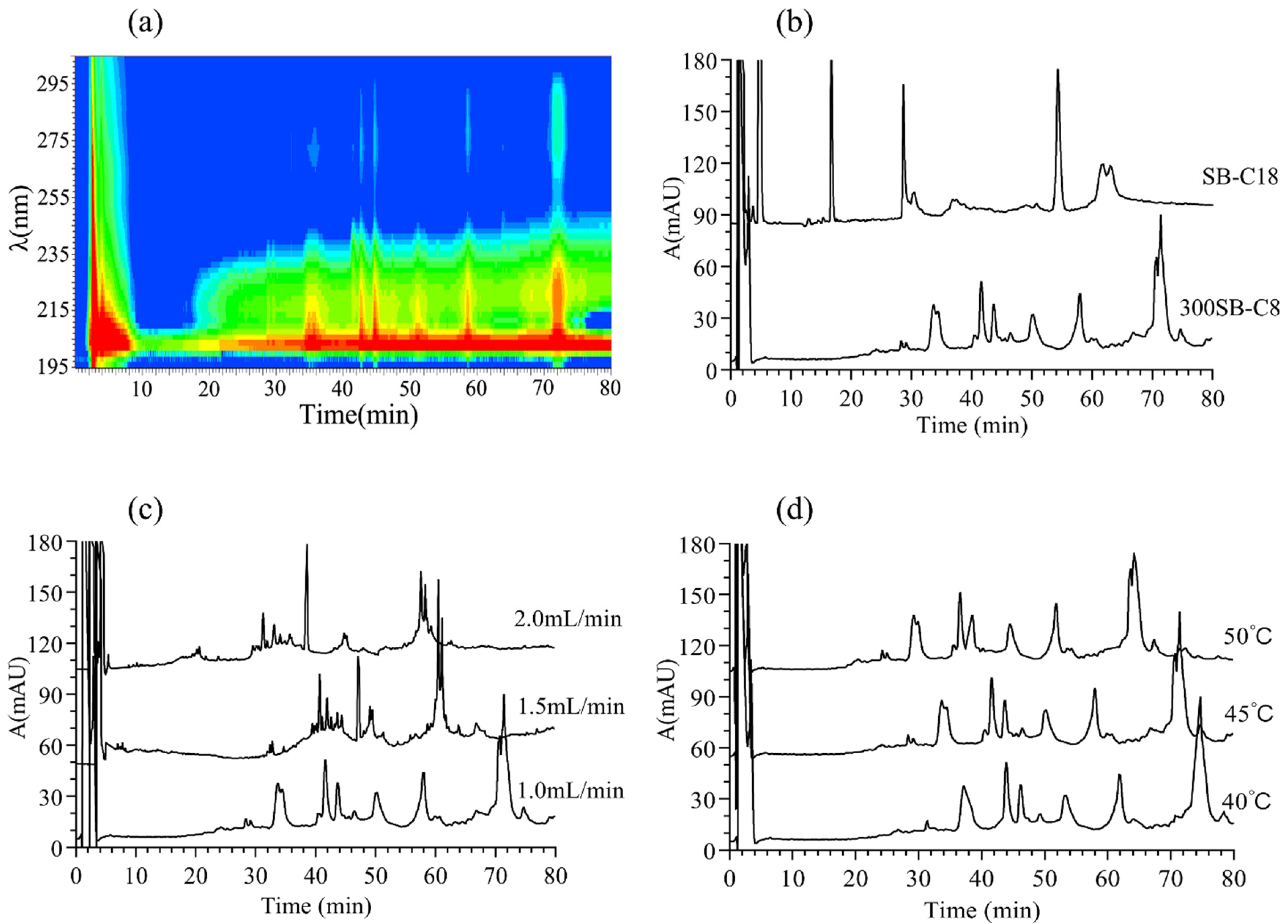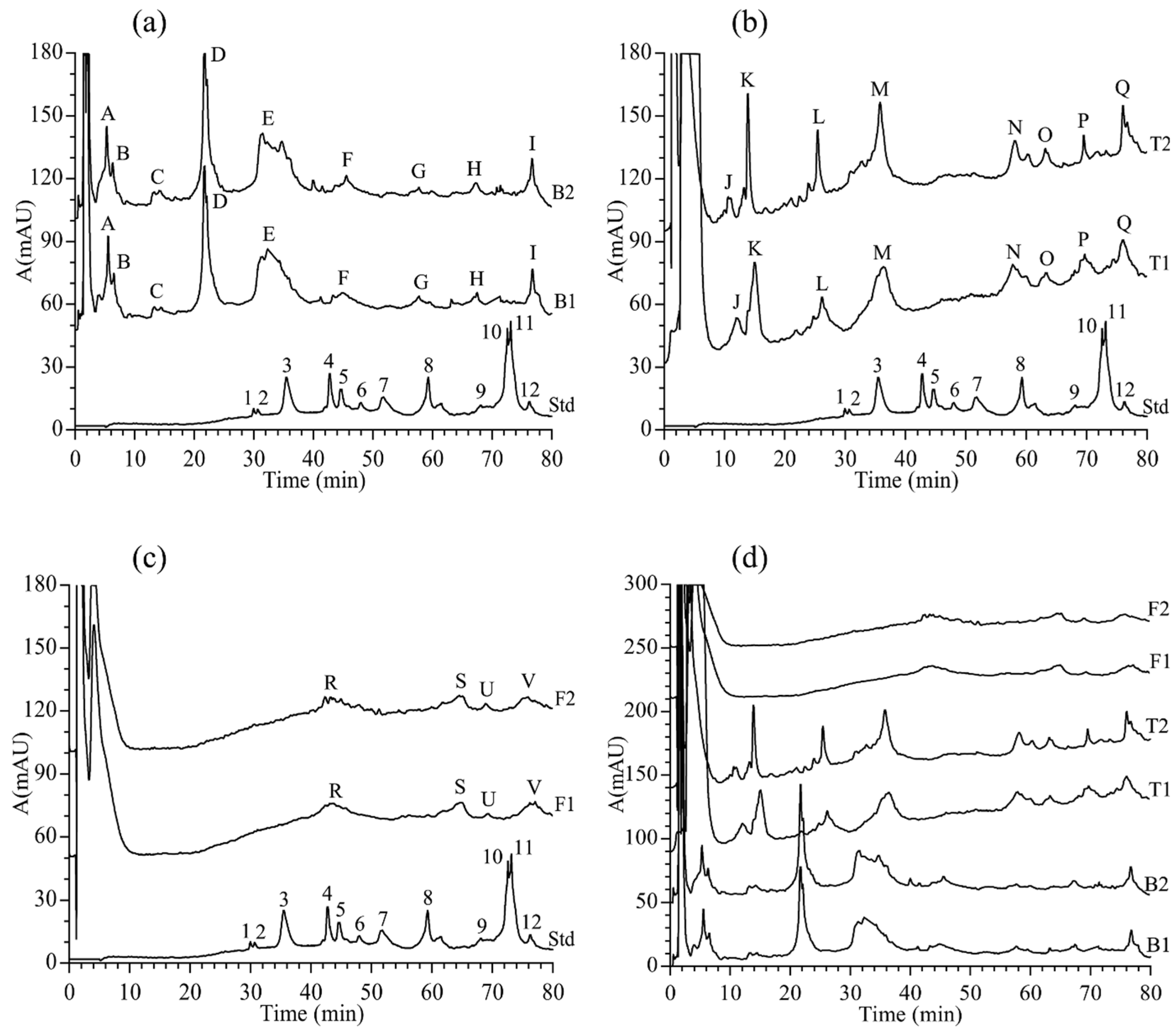Protein-Based Fingerprint Analysis for the Identification of Ranae Oviductus Using RP-HPLC
Abstract
1. Introduction
2. Materials and Methods
2.1. Chemicals and Samples
2.2. Protein Extraction
2.3. RP-HPLC Chromatography Analysis
2.4. Validation of the RP-HPLC Method
2.5. Establishment of the HPLC Fingerprint
2.6. Data Analysis
3. Results and Discussion
3.1. Optimization of the RP-HPLC Conditions
3.2. RP-HPLC Methodology Validation
3.3. HPLC Fingerprint of Ranae Oviductus Protein
3.4. Fingerprint Spectra Analysis
3.5. Hierarchical Cluster Analysis (HCA)
3.6. Principal Component Analysis(PCA)
4. Conclusions
Author Contributions
Funding
Conflicts of Interest
References
- Xie, C.; Zhang, L.J.; Zhang, W.Y.; Yang, X.; Fan, L.; Li, X. Immunomodulatory effect of Oviductus Ranae on the mice. Chin. J. Gerontol. 2010, 30, 3132–3133. [Google Scholar]
- Li, Z.G.; Wang, C. The anti-fatigue effect of protein hydrolysate of Oviductus Ranae on mice and its physiological mechanism. Chin. Sch. Phys. Educ. 2017, 4, 81–87. [Google Scholar]
- Mo, Y.; Yu, M.J.; Mo, Y.L. Protective effect of Oviductus Ranae on D-galactose-induced aging mice. Chin. J. Gerontol. 2011, 31, 1603–1604. [Google Scholar]
- Peng, F.; Xu, F.; Liu, B.; Zhou, B.; Chen, X.; Zhao, Q. Effects of Rana Temporaria Chensinensis David egg oil on blood lipid in hyperlipemia rats. Acad. J. Guangzhou Med. Coll. 2003, 31, 57–59. [Google Scholar]
- He, Z.; Tang, X.; Liu, J.; Yuan, Y.; Jiang, C.; Zhao, Y.; Wang, Y. Application of rapid PCR to authenticate Ranae Oviductus. China J. Chin. Mater. Med. 2017, 42, 2467–2472. [Google Scholar]
- Hou, G.L.; Lu, B.Z.; Wang, C.L. Authentic identification of Ranae Oviductus. Strait. Pharm. J. 2007, 19, 63–64. [Google Scholar]
- Jin, P.; Zhang, Y.; Wang, H.; Lan, M.; Zhang, H.; Sun, J.M. Advances in identification of forest frog oil. Jilin J. Chin. Med. 2018, 38, 1179–1180. [Google Scholar]
- Liu, J.; Liu, S.; Liu, C. True or false identification of oviductus ranae. Heilongjiang Med. Pharm. 2009, 32, 20–21. [Google Scholar]
- Wang, Y.S.; Jiang, D.C.; Bai, X.X.; Wang, E.S. Identification Research Rana temportva Chensinensis David’s Quality with UASLG. Lishizhen Med. Mater. Med. Res. 2006, 17, 2125–2127. [Google Scholar]
- Zhang, W.; Wang, W.N.; Chen, F.F.; Zhang, L.; Yuan, D. Quality evaluation of Oviductus Ranae and similar products and fakes. J. Shenyang Pharm. Univ. 2012, 29, 951–958. [Google Scholar]
- Hu, X.; Liu, C.B.; Chen, X.P.; Wang, L.M. Main nourishment components of Oviductus Ranae. J. Jilin Agric. Univ. 2003, 25, 218–220. [Google Scholar]
- Hou, Z.H.; Zhao, H.; Yu, B.; Cui, B. Comprehensively analysis of components in Oviductus Ranae. Sci. Technol. Food Ind. 2017, 38, 348–352. [Google Scholar]
- Ma, L.; Yang, Y.; Chen, J.; Wang, J.; Bu, D. A rapid analytical method of major milk proteins by reversed-phase high-performance liquid chromatography. Anim. Sci. J. 2017, 88, 1623–1628. [Google Scholar] [CrossRef]
- Han, C.; Lu, X.; Yu, Z.; Li, X.; Ma, W.; Yan, Y. Rapid separation of seed gliadins by reversed-phase ultra performance liquid chromatography (RP-UPLC) and its application in wheat cultivar and germplasm identification. Biosci. Biotechnol. Biochem. 2015, 79, 808–815. [Google Scholar] [CrossRef]
- Rodríguez-Nogales, J.M.; Cifuentes, A.; García, M.C.; Marina, M.L. Characterization of Protein Fractions from Bt-Transgenic and Non-transgenic Maize Varieties Using Perfusion and Monolithic RP-HPLC. Maize Differentiation by Multivariate Analysis. J. Agric. Food Chem. 2007, 55, 3835–3842. [Google Scholar] [CrossRef] [PubMed]
- Xie, P.; Chen, S.; Liang, Y.-Z.; Wang, X.; Tian, R.; Upton, R. Chromatographic fingerprint analysis—a rational approach for quality assessment of traditional Chinese herbal medicine. J. Chromatogr. A 2006, 1112, 171–180. [Google Scholar] [CrossRef]
- Sun, J.; Chen, P. Chromatographic fingerprint analysis of yohimbe bark and related dietary supplements using UHPLC/UV/MS. J. Pharm. Biomed. Anal. 2012, 61, 142–149. [Google Scholar] [CrossRef]
- Lu, G.-H.; Chan, K.; Liang, Y.-Z.; Leung, K.; Chan, C.-L.; Jiang, Z.-H.; Zhao, Z.-Z. Development of high-performance liquid chromatographic fingerprints for distinguishing Chinese Angelica from related umbelliferae herbs. J. Chromatogr. A 2005, 1073, 383–392. [Google Scholar] [CrossRef]
- Sun, X.; Wang, H.; Han, X.; Chen, S.; Zhu, S.; Dai, J. Fingerprint analysis of polysaccharides from different Ganoderma by HPLC combined with chemometrics methods. Carbohydr. Polym. 2014, 114, 432–439. [Google Scholar] [CrossRef] [PubMed]
- Zhu, L.; Fang, L.; Li, Z.; Xie, X.; Zhang, L. A HPLC fingerprint study on Chaenomelis Fructus. BMC Chem. 2019, 13, 7. [Google Scholar] [CrossRef]
- Harrysson, H.; Hayes, M.; Eimer, F.; Carlsson, N.-G.; Toth, G.B.; Undeland, I. Production of protein extracts from Swedish red, green, and brown seaweeds, Porphyra umbilicalis Kützing, Ulva lactuca Linnaeus, and Saccharina latissima (Linnaeus) J. V. Lamouroux using three different methods. J. Appl. Phycol. 2018, 30, 3565–3580. [Google Scholar] [CrossRef]
- Huang, F.; Cockrell, D.C.; Stephenson, T.R.; Noyes, J.H.; Sasser, R.G. Isolation, purification, and characterization of pregnancy-specific protein B from elk and moose placenta. Biol. Reprod. 1999, 61, 1056–1061. [Google Scholar] [CrossRef] [PubMed][Green Version]
- Takakura, D.; Hashii, N.; Kawasaki, N. An improved in-gel digestion method for efficient identification of protein and glycosylation analysis of glycoproteins using guanidine hydrochloride. Proteomics 2014, 14, 196–201. [Google Scholar] [CrossRef]
- Poulsen, J.W.; Madsen, C.T.; Young, C.; Poulsen, F.M.; Nielsen, M.L. Using Guanidine-Hydrochloride for Fast and Efficient Protein Digestion and Single-step Affinity-purification Mass Spectrometry. J. Proteome Res. 2013, 12, 1020–1030. [Google Scholar] [CrossRef]
- Mouecoucou, J.; Villaume, C.; Sanchez, C.; Mejean, L. Effects of gum arabic, low methoxy pectin and xylan on in vitro digestibility of peanut protein. Food Res. Int. 2004, 37, 777–783. [Google Scholar] [CrossRef]
- Vincent, D.; Rochfort, S.; Spangenberg, G. Optimisation of Protein Extraction from Medicinal Cannabis Mature Buds for Bottom-Up Proteomics. Molecules 2019, 24, 659. [Google Scholar] [CrossRef]
- Ali, I.; Aboul-Enein, H.Y.; Singh, P.; Singh, R.; Sharma, B. Separation of biological proteins by liquid chromatography. Saudi Pharm. J. 2010, 18, 59–73. [Google Scholar] [CrossRef]
- Esteve, C.; Del Rio, C.; Marina, M.L.; Garcia, M.C. Development of an ultra-high performance liquid chromatography analytical methodology for the profiling of olive (Olea europaea L.) pulp proteins. Anal. Chim. Acta 2011, 690, 129–134. [Google Scholar] [CrossRef]
- Gao, P.; Shi, B.; Li, Z.; Wang, P.; Yin, C.; Yin, Y.; Zan, L. Establishment and Application of Infant Formula Fingerprints by RP-HPLC. Food Anal. Method. 2018, 11, 23–33. [Google Scholar] [CrossRef]
- Cui, L.L.; Zhang, Y.Y.; Shao, W.; Gao, D.M. Analysis of the HPLC fingerprint and QAMS from Pyrrosia species. Ind. Crop Prod. 2016, 85, 29–37. [Google Scholar] [CrossRef]
- Kannel, P.R.; Lee, S.; Kanel, S.R.; Khan, S.P. Chemometric application in classification and assessment of monitoring locations of an urban river system. Anal. Chim. Acta 2007, 582, 390–399. [Google Scholar] [CrossRef] [PubMed]
- Wang, C.; Zhang, C.-X.; Shao, C.-F.; Li, C.-W.; Liu, S.-H.; Peng, X.-P.; Xu, Y.-Q. Chemical Fingerprint Analysis for the Quality Evaluation of Deepure Instant Pu-erh Tea by HPLC Combined with Chemometrics. Food Anal. Method. 2016, 9, 3298–3309. [Google Scholar] [CrossRef]
- Goodarzi, M.; Russell, P.J.; Vander Heyden, Y. Similarity analyses of chromatographic herbal fingerprints: A review. Anal. Chim. Acta 2013, 804, 16–28. [Google Scholar] [CrossRef]
- Nelson, P.R.C.; MacGregor, J.F.; Taylor, P.A. The impact of missing measurements on PCA and PLS prediction and monitoring applications. Chemom. Intell. Lab 2006, 80, 1–12. [Google Scholar] [CrossRef]
- Esteve, C.; Del Río, C.; Marina, M.L.; García, M.C. First Ultraperformance Liquid Chromatography Based Strategy for Profiling Intact Proteins in Complex Matrices: Application to the Evaluation of the Performance of Olive (Olea europaea L.) Stone Proteins for Cultivar Fingerprinting. J. Agric. Food Chem. 2010, 58, 8176–8182. [Google Scholar] [CrossRef] [PubMed]
- Huang, Y.; Chang, L.; Zhang, S.W.; Yuan, D. Electrophoresis methods for the characterizaiton of Ranae Oviductus and its adulterants. J. Shenyang Pharm. Univ. 2017, 34, 1049–1054. [Google Scholar]
- Fraige, K.; Pereira-Filho, E.R.; Carrilho, E. Fingerprinting of anthocyanins from grapes produced in Brazil using HPLC–DAD–MS and exploratory analysis by principal component analysis. Food Chem. 2014, 145, 395–403. [Google Scholar] [CrossRef] [PubMed]
Sample Availability: Not available. |





| No. | Name of Medicine | Origin | Collection Date |
|---|---|---|---|
| S1 | Ranae Oviductus | Yanbian, Jilin | 2016.3 |
| S2 | Ranae Oviductus | Tonghua, Jilin | 2016.1 |
| S3 | Ranae Oviductus | Yanbian, Jilin | 2016.3 |
| S4 | Ranae Oviductus | Baishan, Jilin | 2015.11 |
| S5 | Ranae Oviductus | Yanbian, Jilin | 2016.3 |
| S6 | Ranae Oviductus | Baishan, Jilin | 2015.11 |
| S7 | Ranae Oviductus | Jilin, Jilin | 2016.12 |
| S8 | Ranae Oviductus | Jilin, Jilin | 2016.12 |
| S9 | Ranae Oviductus | Jilin, Jilin | 2015.11 |
| S10 | Ranae Oviductus | Jilin, Jilin | 2015.11 |
| B1 | Bullfrog Oviduct | Baishan, Jilin | 2016.12 |
| B2 | Bullfrog Oviduct | Baishan, Jilin | 2016.12 |
| T1 | Toad Oviduct | Yanbian, Jilin | 2016.10 |
| T2 | Toad Oviduct | Tonghua, Jilin | 2016.11 |
| F1 | Frog Oviduct | Yanbian, Jilin | 2016.10 |
| F2 | Frog Oviduct | Tonghua, Jilin | 2016.11 |
| No. | Similarity | No. | Similarity |
|---|---|---|---|
| S1 | 0.779 | S6 | 0.976 |
| S2 | 0.906 | S7 | 0.884 |
| S3 | 0.967 | S8 | 0.877 |
| S4 | 0.970 | S9 | 0.980 |
| S5 | 0.970 | S10 | 0.861 |
© 2019 by the authors. Licensee MDPI, Basel, Switzerland. This article is an open access article distributed under the terms and conditions of the Creative Commons Attribution (CC BY) license (http://creativecommons.org/licenses/by/4.0/).
Share and Cite
Gan, Y.; Xiao, Y.; Wang, S.; Guo, H.; Liu, M.; Wang, Z.; Wang, Y. Protein-Based Fingerprint Analysis for the Identification of Ranae Oviductus Using RP-HPLC. Molecules 2019, 24, 1687. https://doi.org/10.3390/molecules24091687
Gan Y, Xiao Y, Wang S, Guo H, Liu M, Wang Z, Wang Y. Protein-Based Fingerprint Analysis for the Identification of Ranae Oviductus Using RP-HPLC. Molecules. 2019; 24(9):1687. https://doi.org/10.3390/molecules24091687
Chicago/Turabian StyleGan, Yuanshuai, Yao Xiao, Shihan Wang, Hongye Guo, Min Liu, Zhihan Wang, and Yongsheng Wang. 2019. "Protein-Based Fingerprint Analysis for the Identification of Ranae Oviductus Using RP-HPLC" Molecules 24, no. 9: 1687. https://doi.org/10.3390/molecules24091687
APA StyleGan, Y., Xiao, Y., Wang, S., Guo, H., Liu, M., Wang, Z., & Wang, Y. (2019). Protein-Based Fingerprint Analysis for the Identification of Ranae Oviductus Using RP-HPLC. Molecules, 24(9), 1687. https://doi.org/10.3390/molecules24091687







